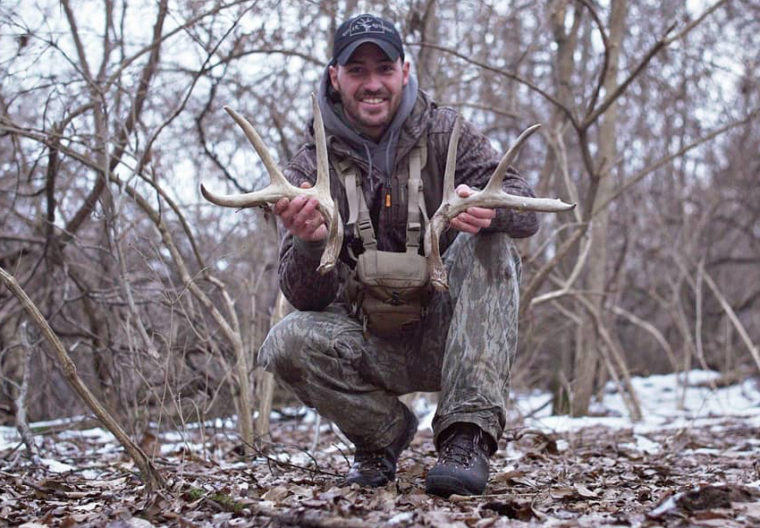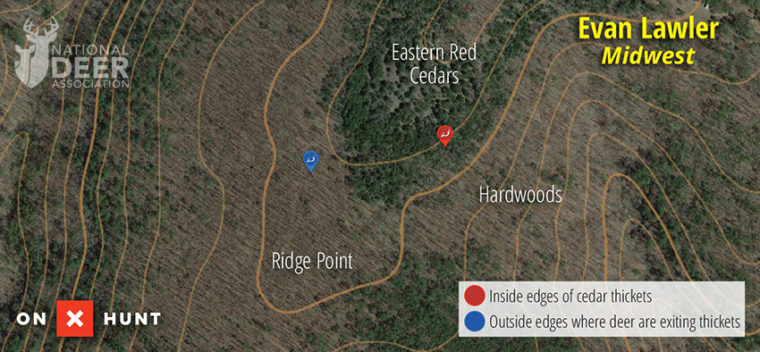I had never read a comprehensive article with shed-hunting strategies for specific regions of the whitetail’s range. So, I wrote one! I interviewed six shed-hunting nuts from the Midwest, Mississippi River Valley, Deep South, Appalachian Mountains, Northeast, and the Northern Great Plains. Let’s look at what Evan Lawler of Missouri had to say about shed hunting the Midwest.
NDA members read my article in Quality Whitetails magazine in 2020. Now, NDA is going to share my article free online, in six parts, and this installment covers the Midwest. To be notified as each part is released, sign up for NDA’s free e-newsletter here.
Each installment of this series is accompanied by a map from the onX Hunt app in that region, showing actual terrain examples you should look for.
Evan Lawler – Missouri
Midwestern farm and timber country is a whitetail hunter’s dream, but not everyone has access to large well-managed parcels of primo hunting land. Evan Lawler, a hardcore shed hunter from southern Missouri, is no stranger to the public-land struggle and has a few highly refined tactics that consistently find him over 70 sheds a year on high-pressure areas.
Evan’s most important strategy for fighting the public-land shed hunting crowds is to get out early. Extremely early. While many people wait for late February or March to avoid spooking deer before shedding, Evan begins his search in late December. The proof is in the pudding, as he typically has 30 or more sheds in his pile before February hits. Evan finds a lot of his bigger sheds in this early time frame. He believes these mature bucks shed early due to the physical rigors of the rut and winter stress on their bodies. When walking early in the shedding season, Evan takes a low-impact approach where he covers a lot of ground by mostly working edges of bedding cover and food. This serves multiple purposes because he is able to mark locations of high deer activity for more thorough searches later, and he doesn’t bust through deer bedrooms and spook bucks out of the area before they shed.
Typically, he will walk the outside edges of young clearcuts and pick an entry trail that has rubs along it. Once inside these thickets, he concentrates on areas with fresh droppings and evidence of deer browse.
Evan prefers walking transition areas over bedding cover or food. He specifically targets edges of different cover types where deer are moving from bedding areas toward food. For instance, if there is an edge of cedar trees bordering open hardwood timber, he will walk 25 to 50 yards off the transition line inside the hardwoods then loop back and walk the same distance back inside the cedars. Evan has picked up some of his best sets of sheds along these edges and has found several extremely fresh sheds on top of snow just outside these cedar thickets following big storms. His theory is that when bucks exit the thermal cover following a winter storm, they shake snow or other precipitation off their backs, jarring loose antlers from their heads. It’s a straightforward theory, and regardless of how these antlers are shed, areas in and around cedar thickets consistently produce for Evan when winter weather hits.
Evan also never passes up an opportunity to check water sources, walking heavy trails leading to ponds, creek crossings and the water’s edge. He would much rather walk grassy filter strips running along or through ag fields than the more traditional approach of grid-searching these fields. Clearcuts are also fair game for Evan and have produced a lot of sheds over the years. Typically, he will walk the outside edges of young clearcuts and pick an entry trail that has rubs along it. Once inside these thickets, he concentrates on areas with fresh droppings and evidence of deer browse. Evan has picked up 70-inch-plus sheds in areas of these clearcuts that are so thick he can barely reach the shed.
Next week, we’ll head to the Mississippi River Valley with Brady Bradley of Arkansas. Stay tuned, and remember to sign up for NDA’s e-newsletter to get all of NDA’s deer hunting content as soon as it’s available.

